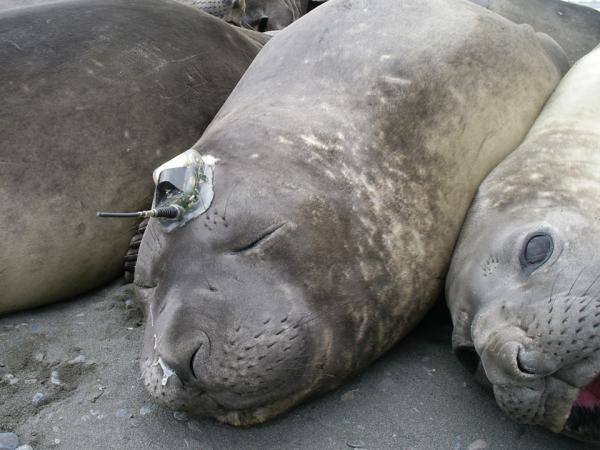Sea seals help provide climate data
According to an article published by a group of French, Australian, American and British scientists on the Proceedings of the National Academy of Sciences, special oceanographic sensors attached to elephant seals (sea elephants) can provide data about southern waters 30 times larger than conventional techniques.
Co-author, Dr. Steve Rintoul of the Center for Climate and Antarctic Ecosystem Studies (ACE CRC) and CSIRO's Wealth of the National Marine Research Ship said: 'This has allowed us for the first time. Observe the vast sea areas under the winter ice. '
'With conventional oceanographic methods, we cannot observe those areas, especially the Antarctic continental shelf where the most important changes of water bodies take place. That's why so far our ability to express high latitudes and sea ice in ocean and climate models is limited. '
 Special oceanographic sensors mounted on elephant seals can provide up to 30 times more data on southern waters than conventional techniques. (Photo: Dr. Martin Biuw).
Special oceanographic sensors mounted on elephant seals can provide up to 30 times more data on southern waters than conventional techniques. (Photo: Dr. Martin Biuw).
Co-author, University of Tasmania professor Mark Hindell said elephant seal data complements traditional oceanographic sampling from ships, satellites and drift buoys. He said: 'By providing marine data beneath the ice, seals are helping us to establish the global marine observation system needed to detect and capture ocean changes'.
Polar regions play an important role in the earth's climate system and are changing faster than anywhere in the world. In the southern hemisphere, limited observations show that the southernmost polar region has warmed faster than the global average. The dense blocks of water forming near Antarctica and moving to lower latitudes cool in some locations and warm up in some other locations. Polar changes are important because they include flow, sea ice and carbon cycles that can accelerate the rate of change.
The crane moved 35-65 km a day with 16,500 records of data collected from 2004-2005. Of these, 8000 records were obtained in the south of 60S, 9 times more than what was obtained from floats and ships. 4,520 records were obtained from glacial waters, 30 times the amount of normal data. The seals dive to an average depth of more than 500 meters and a maximum of nearly 2000m. The Australian team consists of scientists from CSIRO, ACE CRC, University of Tasmania, Marine Science Center and Charles Darwin University.
- Elephant seals help study the Antarctic bottom
- Seals can become extinct due to climate change
- The secret to pre-existing natural danger of hat seals
- Seeing the mini version yourself, seals do surprises
- 7,000 Russian seals are in danger of being destroyed
- Seals stray between forests in Sweden
- Seals of film production in the United States
- Beam of photos: The sunshine smile of a seal
- Strange image: Seals cut shark meat
- SQL Server 2005 - Next generation data analysis and management software
- The seal seals down the cliff for fear of people
- The mystery of 130 massive dead seals in the world's deepest lake
 Surprised: Fish that live in the dark ocean still see colors
Surprised: Fish that live in the dark ocean still see colors Japan suddenly caught the creature that caused the earthquake in the legend
Japan suddenly caught the creature that caused the earthquake in the legend A series of gray whale carcasses washed ashore on California's coast
A series of gray whale carcasses washed ashore on California's coast Compare the size of shark species in the world
Compare the size of shark species in the world Ancient ocean floor discovered surrounding Earth's core
Ancient ocean floor discovered surrounding Earth's core  Why does it take 700,000 liters of water to train the ChatGPT model?
Why does it take 700,000 liters of water to train the ChatGPT model?  More confirmation about alien life world captured by NASA
More confirmation about alien life world captured by NASA  Explore the universe through the most detailed 3D virtual reality map
Explore the universe through the most detailed 3D virtual reality map  Solving 'traffic jams' in space
Solving 'traffic jams' in space  How long do CDs and DVDs last?
How long do CDs and DVDs last? 